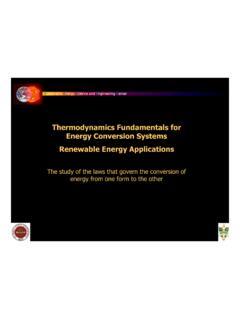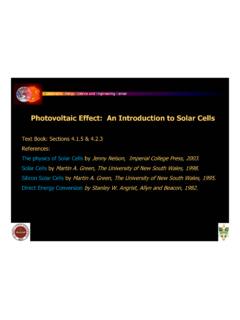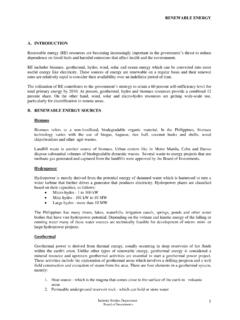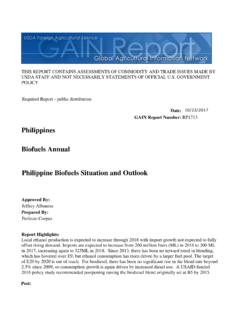Transcription of Sustainable Energy Sources - Florida State University
1 SustainableEnergyScience andEngineeringCenterGEOTHERMAL ENERGYS ource: Energy SourcesSustainableEnergyScience andEngineeringCenterEarth s Temperature ProfileSource: andEngineeringCenterTemperature GradientSource: andEngineeringCenterPlate TectonicsSource: 's crust is broken into huge plates that move apart or push together at about the rate our fingernails grow. Convection of semi-molten rock in the upper mantle helps drive plate andEngineeringCenterSource: crust forms along mid-ocean spreading centers and continental rift zones. When plates meet, one can slide beneath another. Plumes of magma rise from the edges of sinking plates. Plate TectonicsSustainableEnergyScience andEngineeringCenterMagmaSource: or fractured crust allows magma to rise to the surface as lava.
2 Most magma doesn't reach the surface but heats large regions of underground andEngineeringCenterRain Water EffectSource: can seep down faults and fractured rocks for miles. After being heated, it can return to the surface as steam or hot water. SustainableEnergyScience andEngineeringCenterSteaming GroundSource: steaming ground is in the Philippines. SustainableEnergyScience andEngineeringCenterGeothermal ReservoirSource: the rising hot water and steam is trapped in permeable and porous rocks under a layer of impermeable rock, it can form a geothermal reservoir. geothermal reservoirs can reach temperatures of 370oC.
3 SustainableEnergyScience andEngineeringCenterGEOTHERMAL Energy REGIONSS ource: andEngineeringCenterGeothermal WellSource: photograph shows a vertical geothermal well test in the Nevada andEngineeringCenterGeothermal PlantSource: steam from the production wells power the turbine generator. The steam is condensed by evaporation in the cooling tower and pumped down an injection well to sustain andEngineeringCenterSource: electricity production with no fuels are GeneratorSustainableEnergyScience andEngineeringCenterOutdoor Turbine GeneratorSource: generator outdoors at an Imperial Valley geothermal power plant in andEngineeringCenterEnvironmentSource: geothermal plants are operating successfully in a philippine cornfield, at Mammoth Lakes, Calif.
4 , in the Mojave Desert of California, and in a tropical forest, at Mt. Apo, Philippines. SustainableEnergyScience andEngineeringCenterPower Plant TypesSource: Steam: In dry steam power plants, the steam (and no water) shoots up the wells and is passed through a rock catcher and then directly into the turbine. Dry steam fields are Stream: Flash steam power plants use hot water reservoirs. In flash plants, as hot water is released from the pressure of the deep reservoir in a flash tank, some if it flashes to Cycle: In a binary cycle power plant, the heat from geothermal water is used to vaporize a "working fluid" in separate adjacent pipes.
5 The vapor, like steam, powers the turbine andEngineeringCenterGeothermal PowerSource: andEngineeringCenterGlobal geothermal PowerSource: power plants are producing over 8,200 MW of electricity in 21 countriesSustainableEnergyScience andEngineeringCenterPollution Source: , Iceland, was taken in 1932, when buildings were all heated by burning of (imported) fossil fuels. SustainableEnergyScience andEngineeringCenterTowards Sustainable EnergySource: , about 95% of the buildings in Reykjavik are heated with geothermal water. Reykjavik is now one of the cleanest cities in the andEngineeringCenterGeothermal ResourceSustainableEnergyScience andEngineeringCenterUS geothermal PotentialSource: andEngineeringCenterHeat PumpsSource: andEngineeringCenterNuclear PowerTaxpayer Subsidy:From 1948 to 1998, 59% of R&D funding ($66 billion in constant 1999 dollars) went to nuclear power, 23% to fossil Energy ($26 billion), 11% to renewable Energy ($12 billion), and 7% to Energy efficiency ($8 billion).
6 Despite this massive infusion of federal funds (and billions more in indirect subsidies, such as the Price Anderson limits on nuclear industry liability for accidents), nuclear power has not become a major player in our national Energy mix. Today, nuclear power contributes approximately 8% of total Energy supply and 20% of electricity Power is not competitive:In the , 27 reactors have been closed after operating for an average of 15 years. This amounts to 37% of the licensed and projected lifetime of reactors. This empirical trend flies in the face of the industry s claims of reliability and challenges the industry s assertions that the technology, through relicensing and new construction, is a viable strategy for addressing climate change.
7 In 1998, the Washington International Energy Group, an Energy industry analyst, released an update to its study: Nuclear Power Plants and Implications of Early Shutdown for Future Natural Gas report evaluated the performance of nuclear power plants and found that among the 72 reactor sites (each site includes one or more reactors), 34 sites will likely not be able to compete in their deregulated regional market. The owners of six reactors at these sites have already announced permanent andEngineeringCenterEnergy Efficient Home Double-pane windows with low-e (emissivity) coating can reduce heating bills by 34 percent in cold climates compared to uncoated, single-pane windows.
8 In hot climates, spectrally selective low-e windows can cut cooling costs by 38 percent. For each degree households lower their thermostats in winter, they can save about 3 percent on heating bills. An Energy Star furnace could save $1,700 relative to an old furnace, or $1,000 over the lifetime of a standard new furnace. If every household in the switched to Energy Star light fixtures, we could save 70 billion kilowatt-hours and prevent 100 billion pounds of CO2 per year --equivalent to removing 10 million cars from the road. Refrigerators in the alone use the equivalent of the output of more than 20 large nuclear power plants.
9 If all the nation s households used the most efficient refrigerators, electricity savings would eliminate the need for about 10 large power plants. Every kilowatt-hour (kWh) of electricity you avoid using saves more than 1-1/2 pounds of CO2 from being pumped into the atmosphere. If over the next 15 years, Americans bought only Energy Star products, we would shrink our Energy bills by more than $100 billion and eliminate as much greenhouse gas pollution as is produced by 17 million cars for each of those 15 andEngineeringCenterEnergy Efficiency in TransportationImprovements in the average fuel economy of new cars and light trucks from around 1975 through the mid-1980s, were significant.
10 The average fuel economy of cars almost doubled in that time period and for trucks it increased by more than than 50 percent. These improvements were due mainly to the Corporate Average Fuel Economy (CAFE) standards enacted in the current CAFE standards by 60 percent to 44 MPG for cars and 33 MPG for light trucks by 2012, with further increases after that date, are technically and economically feasible. Raising the CAFE standards as suggested here would save million barrels per day (MBD) of gasoline by 2010 and MBD by 2020. SustainableEnergyScience andEngineeringCenterEnergy GoalsAccessibilityto modern Energy means that Energy must be available at prices which are both affordable (low enough for the poorest people) and Sustainable (prices which reflect the real costs of Energy production, transmission and distribution to support the financial ability of companies to maintain and develop their Energy services); Availabilityrelates to long-term continuity of Energy supply as well as to short term quality of service, because an Energy or an electricity shortage can also be disruptive for economic development.











